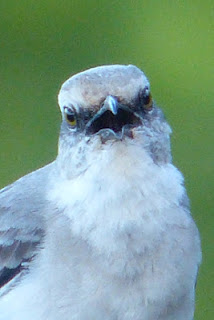There were some great twosomes, like this father dog his "mini-me" pup I observed at Mount Saint Benedict, Trinidad:
It looked to all the world like the senior dog was showing the youngster the ropes, as any devoted dad would, and the little pup was avidly watching his father's every move.
Then there were these two companionable doves who appear to be caught up practising some dance moves:
In Grenada I observed this solitary tern who rejected perching with his flock on their favourite fishing boat, preferring instead a neighbouring boat and the company of a small shorebird:
Of course there were some wonderful feathered faces, like this captive blue and gold macaw in who I photographed enjoying its lunch in Trinidad.
My enjoyment of tame birds like this one has been forever altered by seeing them in the wilds of Guyana. A long life in solitary captivity (they live an average of 50 years and mate for life) seems like a poor substitute for an athletic, social bird who was meant to be soaring free above the vast rainforest canopy. However, these birds were hunted to extinction in Trinidad some decades ago, and a small population has recently been re-established in the protected Nariva Swamp area through the release of captive-bred birds. For the sake of species preservation it seems that captivity for some individuals is a necessary evil.
Another bird I photographed in Trinidad enjoying a snack was this palm tanager who was munching on some sort of fruit:
 |
| "Treasure of Nariva" (silk painting) |
Tanagers are very common in this part of the world and come in some stunning varieties, such as the lovely blue-grey species. I observed this one perched on a gutter:
I have also photographed songbirds who may not be the most interesting to look at but who make up for it with their striking vocalizations, like this wren:
And like this chachalaca (locally called a cocrico) I spotted in Tobago's Grafton Bird Sanctuary.
They're a boring-looking brown, chicken-like birds but their loud, exotic squawks and hoots are like something from the soundtrack of a 1930s Tarzan movie.
Everywhere I travelled, tropical mockingbirds could be heard warbling their melodic songs:
These mockingbirds are a species that appear to have adapted well to urban life. I recently completed a coloured pencil drawing of a tropical mockingbird posed in front of a weathered sign near my apartment in Trinidad.
I intended the image to depict the concept of the urban jungle - a melding of wild and human habitat where wildlife has made necessary adaptations in order to survive, but how the toll of natural forces gradually erodes human structures and reclaims the land, perhaps one day giving it back to the wild creatures.
 |
| "Song of the Tropics: Mockingbird" (coloured pencil) |
On a less serious note, this jaunty Muscovy duck had a twinkle in its eye, maybe because it was living in a sanctuary and therefore not destined for the dinner table:
I photographed this wee hummingbird stretching its wings while sticking its tongue out!
One of the strangest birds I encountered was this boat-billed heron in Guyana (it's a night fisher who roosts in the forest by day):
And then there was this weird looking bare-eyed thrush - so named for the rings of wrinkly yellow skin that surround its eyes (I saw this one in Tobago):
Another leathery-faced bird I encountered - a brown pelican - appeared as though it would rather be napping than keeping an eye on me.
One of the most striking creatures I saw in my travels is this green anaconda:
Eighteen feet long, 32" in circumference, and weighing over 200 pounds, it was captured just weeks ago beside a roadway a few miles from my apartment in Trinidad. Now in the custody of the zoological society, the snake is resting under observation and veterinary care while humans determine its future. While wild release would be preferable no decision has yet been made public.
Another Goliath I observed was this massive grasshopper-like insect that was easily 8" long from head to tail.
It was comfortably perched on a dining room chair at the lodge where I stayed in Guyana and posed quite nicely for me.
Of slightly lesser stature is this fat toad who came to sit below an outdoor faucet at my apartment in Trinidad:
Locally called a crapaud (pronounced in Trinidad as "crap-o"), these plump amphibians are relatively common, likely because they secrete poisonous mucus through their skin if they feel threatened. This one appeared to be thriving.
I have seen and photographed so many interesting creatures that its difficult to select just a few, but this turtle is one of them:
Not particularly large or remarkable, but what a face! And he/she posed so nicely for me.
I'll close with this image of a kiskadee flycatcher:
About the size of a jay, they're named for their raucous, repetitive "kiss-ka-dee" call - I can hear them outside my window as I write this. I captured this particular photograph in Guyana but I've seen these birds everywhere I've travelled. They are not at all shy and can be seen perched on telephone lines, tree branches, fenceposts - you name it - and at virtually any hour of the day. They are, for me, an emblem of my winter stay in this tropical part of the world. Just one of the many unforgettable faces I've encountered during my winter sojourn in the southern Caribbean.

































